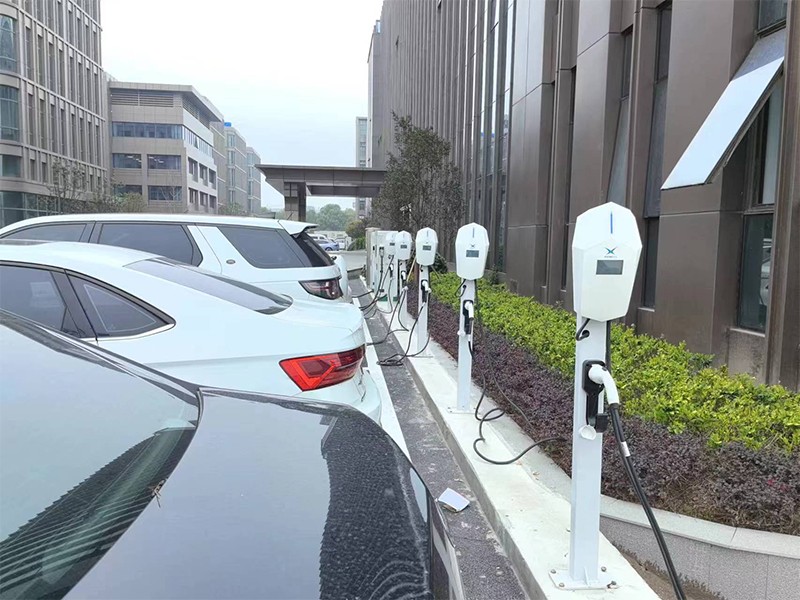Why Do Universities Need EV Charging Stations?
As electric vehicles gain global traction, universities, as hubs of innovation and education, face increasing demand to provide charging facilities for students, faculty, staff, and visitors. Research indicates that installing charging stations not only supports environmental goals but also enhances campus appeal to eco-conscious individuals. Additionally, charging stations can generate revenue through fees and offer research opportunities for students in fields like engineering and environmental science.

Suitable Charging Solutions for Universities
University campuses typically require chargers suited for long parking durations. Level 2 chargers (240 volts, 4-8 hours to full charge) are the preferred choice for most campuses, as they align with the parking patterns of students and staff. DC Fast Chargers (DCFC), while faster (20 minutes to 1 hour), are more expensive and better suited for high-traffic areas like event centers or visitor parking lots. Level 1 chargers (120 volts, up to 24 hours) are generally unsuitable for universities due to their slow charging speeds.
Implementation Steps
Universities can plan and install charging stations through the following steps:
-
Assess Demand: Survey the number of EV owners on campus and potential users.
-
Select Locations: Choose spots near dormitories, faculty parking lots, or high-traffic areas.
-
Partner with Utilities: Evaluate power supply capacity and necessary upgrades.
-
Choose Charger Types: Prioritize Level 2 chargers, with DC Fast Chargers for specific high-traffic areas if needed.
-
Secure Funding: Explore federal, state, and local funding opportunities to reduce costs.
-
Ensure Compliance: Adhere to local regulations and building codes.
Funding and Incentives
Federal and state programs offer funding to support university charging station installations. For example, the Bipartisan Infrastructure Law provides billions through the National Electric Vehicle Infrastructure (NEVI) program and the Charging and Fueling Infrastructure Grant Program. Additionally, some states, like Colorado’s Charge Ahead Colorado, offer up to 80%-90% reimbursement for charging station installation costs for public universities. Universities should collaborate with utilities and clean energy organizations to maximize funding opportunities.
EV Charging Solutions for Universities
Introduction
As electric vehicles (EVs) become more prevalent, universities, as centers for fostering future leaders and innovation, are emerging as key platforms for supporting sustainable transportation. By installing EV charging stations on campus, universities can meet the charging needs of students, faculty, staff, and visitors while advancing sustainability goals, attracting eco-conscious individuals, and providing hands-on academic research opportunities. This article explores the importance of EV charging stations for universities, their benefits, suitable charging solutions, successful case studies, implementation strategies, available funding and incentives, and future trends.
The Importance of EV Charging for Universities
Universities play a critical role in driving societal change and fostering environmental awareness. Studies show that deploying EV charging stations can significantly reduce greenhouse gas emissions, supporting universities’ carbon neutrality goals. Moreover, as the EV market grows, the proportion of EV owners among students and staff is increasing, making charging infrastructure a practical necessity. According to ChargePoint, the number of charging stations on U.S. university campuses grew by 35% between 2018 and 2019, reflecting the accelerating trend.
Benefits
Environmental Impact
EV charging stations reduce carbon emissions by encouraging the use of electric vehicles over traditional gas-powered cars. This aligns with sustainability initiatives like the American College & University Presidents’ Climate Commitment, helping campuses lower their carbon footprint.
Attracting Students and Staff
A 2021 Princeton Review survey found that 75% of college applicants say a university’s environmental commitment influences their decision to apply or attend. Offering EV charging stations makes universities more appealing to students and staff who own or plan to purchase EVs, boosting enrollment and staff retention.
Revenue Generation
Universities can generate revenue by charging for station use. For example, they could implement a semester-based fee model for students, similar to parking permits, or charge visitors per kilowatt-hour or charging session. This revenue can support other campus initiatives.
Educational Opportunities
Charging stations provide hands-on learning opportunities for students in engineering, environmental science, and urban planning. They serve as “living laboratories” for researching sustainable transportation technologies, fostering academic innovation.
Community Engagement
By opening charging stations to the public, universities can serve surrounding communities, support local EV adoption, and position themselves as community leaders in sustainability.
Suitable Charging Solutions for Universities
EV charging stations are categorized into three main types: Level 1, Level 2, and DC Fast Charging (DCFC).
|
Charger Type |
Voltage |
Charging Time |
Applications |
Suitability for Universities |
|---|---|---|---|---|
|
Level 1 |
120V |
20-24 hours |
Residential, emergency backup |
Unsuitable due to long charging times |
|
Level 2 |
240V |
4-8 hours |
Workplaces, public parking |
Ideal for student and staff long-term parking |
|
DC Fast Charging (DCFC) |
High-voltage DC |
20 minutes to 1 hour |
Highways, high-traffic areas |
Suitable for event centers or visitor parking |
Level 2 chargers are the preferred choice for university campuses, as they align with the long parking durations of students and staff during classes or work hours. DC Fast Chargers, while faster, are more costly to install and operate, making them suitable only for high-traffic areas like sports facilities or visitor parking lots. Level 1 chargers are generally impractical for university settings due to their slow charging speeds.
Successful Case Studies
University of Georgia
A case study analyzing three ChargePoint charging stations at the University of Georgia (UGA) from 2014 to 2017 found that 77.4% of charging sessions lasted less than 3 hours, 91.8% of energy delivered was below 18 kWh, and the average power was 4.4 kW. Users were primarily local (49.41% from the Athens area), indicating that the stations mainly served students, staff, and local visitors. These insights provide valuable data for other universities planning charging infrastructure.
University of California, Davis (UC Davis)
According to ChargePoint, UC Davis has 38 charging points on the ChargePoint network, making it one of the most EV-charging-equipped campuses in the U.S. This demonstrates how leading universities are supporting EV adoption through large-scale charging deployments.
Planning and Implementation
Universities should follow these steps to plan and install EV charging stations:
-
Demand Assessment: Conduct surveys to understand the number of EV owners on campus and potential user demand.
-
Location Selection: Choose strategic locations near dormitories, faculty parking lots, or high-traffic areas like libraries or student centers.
-
Utility Collaboration: Work with local utilities to assess power supply capacity and determine if upgrades are needed.
-
Charger Type Selection: Prioritize Level 2 chargers, with DC Fast Chargers for specific high-traffic areas if necessary.
-
Networking Decision: Decide whether to use networked chargers (supporting data collection and payment processing) or non-networked chargers (basic charging functionality).
-
Budget and Funding: Develop a budget and explore federal, state, and local funding opportunities to offset costs.
-
Compliance: Ensure compliance with local building codes, permitting requirements, and accessibility standards (e.g., ADA compliance).
The Alternative Fuels Data Center (AFDC) provides a detailed guide on EV charging infrastructure development, offering further guidance for universities.
Funding and Incentives
Universities can leverage multiple funding sources to support EV charging station installations:
-
Federal Programs: The Bipartisan Infrastructure Law (BIL) allocates $5 billion through the National Electric Vehicle Infrastructure (NEVI) program and $2.5 billion through the Charging and Fueling Infrastructure Grant Program. These programs support charging station deployment in public spaces, including university campuses.
-
State Programs: Some states offer specific grants for public universities. For example, Colorado’s Charge Ahead Colorado program provides up to 80%-90% reimbursement for charging station installation costs for eligible public entities, including universities.
-
Utility Incentives: Some utilities offer discounts or grants for charging station installations. For instance, Pacific Gas and Electric (PG&E) provides incentives for schools and educational institutions to install charging infrastructure.
-
Other Grants: Universities can explore funding opportunities from clean energy organizations (e.g., Clean Cities Coalitions) or nonprofit institutions.
Universities should collaborate with utilities, state energy offices, and federal agencies to identify and apply for these funding opportunities.
Future Trends
As the EV market continues to grow, the demand for charging infrastructure on university campuses will increase further. Technological advancements, such as faster charging times and wireless charging, may reshape future charging station designs. Additionally, integrating renewable energy sources (e.g., solar power) with charging stations can enhance universities’ sustainability efforts. Universities may also expand charging networks through partnerships with surrounding communities, serving off-campus student housing or local businesses.


